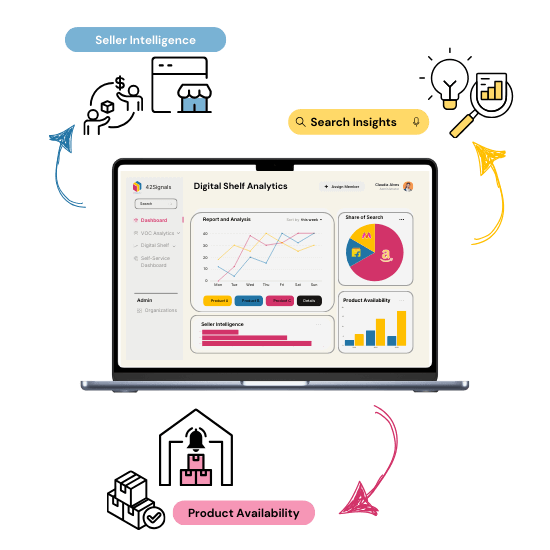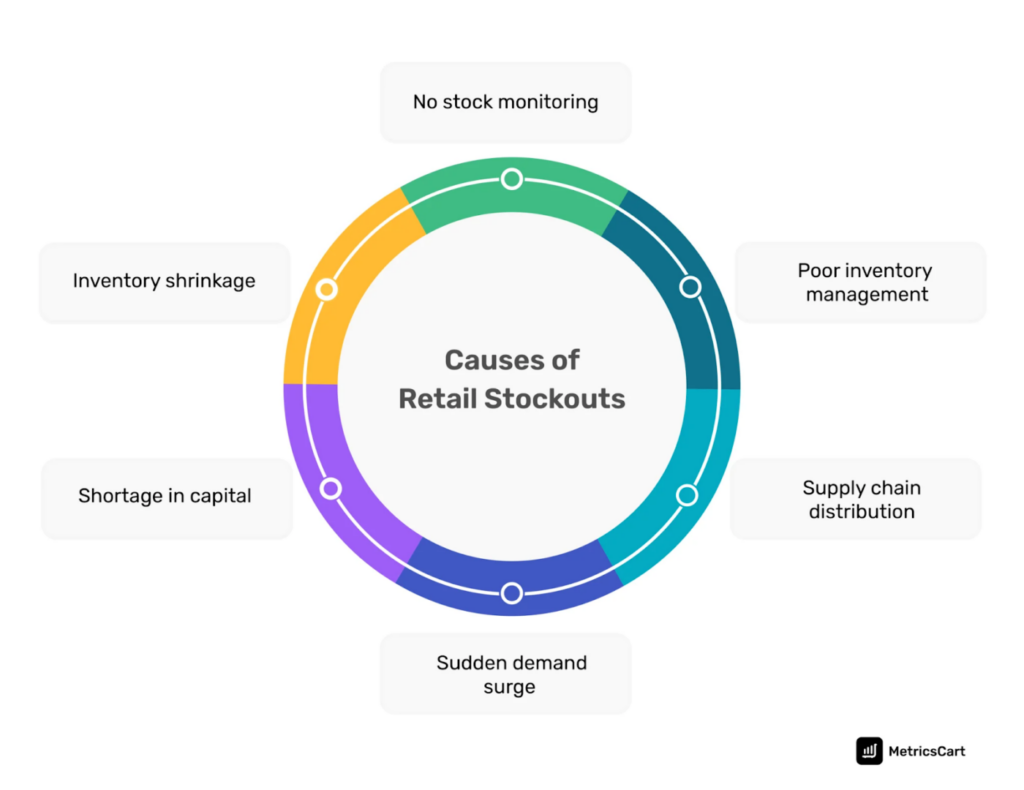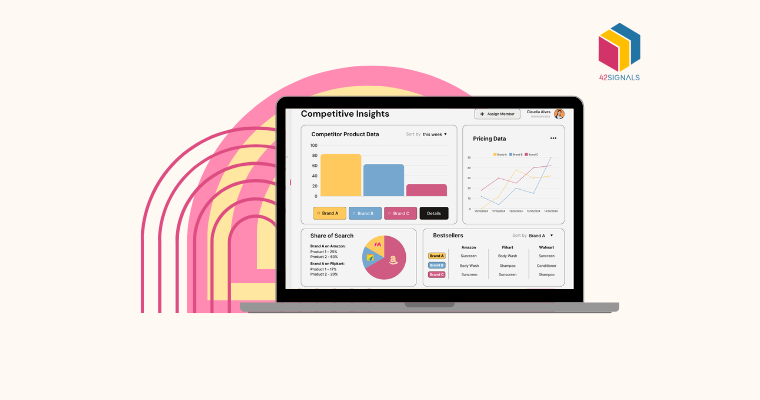As e-commerce continues to grow, businesses must adopt more sophisticated ways to monitor competitors and analyze the landscape. Hence, the need for a competitor dashboard.
A competitor dashboard consolidates competitive data into one platform, giving you real-time insights into market trends, pricing, inventory, customer preferences, and more.
Let’s look at how competitor dashboards can help your business.
What is a Competitor Dashboard?
A competitor dashboard is a data-driven tool that aggregates and visualizes competitive insights. It allows e-commerce businesses to monitor various aspects of their competitors, such as pricing, promotions, product availability, and customer feedback.

The data is then displayed in an easy-to-understand format, helping you make more informed decisions quickly.
This is different from traditional competition analysis, where you would manually gather information or use basic tools to track competitors.
With a competitor dashboard, you have a centralized, real-time source of intelligence that keeps you informed of every move your competitors make.
The Role of Competitor Dashboards in E-Commerce
1. Real-Time Pricing Insights
One of the most significant advantages of using a competitor dashboard is the ability to monitor your competitors’ pricing strategies.
E-commerce is highly competitive, and pricing plays a crucial role in attracting customers. By using a competitor dashboard, you can easily track price fluctuations, identify discount patterns, and understand how competitors position their products in the market.
Imagine launching a new product. A competitor dashboard allows you to see how your rivals are pricing similar products, whether they’re running promotions, and how customers are reacting to those prices.
This kind of ecommerce analytics ensures that you are not pricing yourself out of the market or leaving money on the table.
2. Digital Shelf Analytics

The digital shelf refers to the online platforms where your products are displayed to potential customers, whether that’s your website or a third-party marketplace like Amazon or Walmart.
Digital shelf analytics offered by a competitor dashboard help you analyze how your products and your competitors’ products appear in search results, product listings, and customer reviews.
This type of competitive data is invaluable for improving product discoverability, optimizing product titles, and enhancing product descriptions.
With insights into which products perform best and why, you can optimize your digital shelf presence and stand out from the competition.
This can drive higher conversion rates and improve customer loyalty.
3. Customer Sentiment and Review Analysis
Understanding customer sentiment is a key aspect of competition analysis, and competitor dashboards are excellent for tracking this.
They provide you with tools to monitor customer reviews, star ratings, and feedback across multiple platforms.

Image Source: Support Logic
These insights can help you identify not only what customers love about your competitors’ products but also where they are falling short.
For instance, if customers frequently complain about a specific feature of a competitor’s product, you can take that information and either improve your own offering or highlight your product’s superiority in that area.
Conversely, if a competitor receives positive reviews for certain product attributes, you can adjust your strategy to match or exceed their offering.
4. Inventory and Stock Management
Another area where competitor dashboards can revolutionize your e-commerce strategy is inventory tracking.
If a competitor runs out of stock on a popular item, you can capitalize on the opportunity by adjusting your stock levels or increasing marketing efforts for similar products.

This type of competitive data gives you a significant edge, allowing you to respond dynamically to market changes.
Monitoring stock availability across multiple competitors can help you anticipate demand trends and ensure that you never miss out on sales due to stock shortages.
5. Promotion and Discount Strategy
Competitor dashboards allow you to track ongoing promotions and discounts across the market.
When competitors offer sales or limited-time discounts, you need to react quickly to retain your customer base.
With a competitor dashboard, you can align your own promotions to stay competitive.
The platform not only helps you identify discount patterns but also provides insights into which promotions are most successful.
Armed with this information, you can design targeted campaigns that not only compete but outshine your rivals, boosting both your sales and brand visibility.
How Competitor Dashboards Can Enhance Decision-Making?
A competitor dashboard does more than just provide data—it empowers you to make strategic decisions backed by current insights.
Here are a few ways this tool can improve decision-making within your organization:
- Data-Driven Pricing: Knowing what your competitors are charging allows you to make data-driven pricing decisions.
You can set competitive prices that attract more customers without sacrificing margins.
- Product Development: By analyzing competitor products, their reviews, and customer feedback, you can identify gaps in the market.
This helps you develop or improve products that better meet customer needs.
- Marketing Optimization: Competitor dashboards reveal which marketing strategies and promotions are driving the most success for your competitors.
You can use this information to adjust your own campaigns and improve ROI.
- Performance Benchmarking: Use the insights to benchmark your own performance against competitors.
Whether it’s in sales volume, pricing, or customer sentiment, you’ll have a clearer understanding of where your business stands and how you can improve.
In What Ways Can Competitor Dashboards Aid Long-Term Growth?
To fully realize the potential of competitor analysis dashboards, it’s essential to integrate them into your broader business strategy.

E-commerce is dynamic, and your competitors are constantly evolving. A robust dashboard will not only keep you informed about immediate competitive threats but will also help you plan for long-term growth.
Here are a few ways you can leverage competitor dashboards for sustainable success:
- Strategic Planning:
Use competitor insights to inform your long-term business strategy. Whether you’re launching a new product line or entering a new market, competitive data can help you refine your approach.
- Market Trend Analysis:
Competitor dashboards can help you identify emerging market trends. By monitoring the product offerings, competitor pricing strategies, and marketing tactics of leading brands in the industry, you can stay ahead of the curve and anticipate shifts in customer behavior.
- Customer Retention:
Regularly analyzing competitor reviews and feedback helps you better understand what customers value. You can then adjust your own offerings to meet customer expectations, improving customer satisfaction and retention over time.
- Profit Margin Protection:
With the ability to monitor your competitors’ pricing and promotions, you can avoid getting caught in a price war. A data-driven approach allows you to price competitively without drastically cutting into profit margins.
Conclusion
A competitor dashboard is a powerful tool that can transform how you approach competition analysis.
In the long run, this will lead to a more agile, competitive, and successful e-commerce business.
42Signals can help you visualize your competitors and their strategies in an easy-to-understand intuitive format.
If you are curious to know how it can be adapted to your brand and competitors, schedule a demo with us today.



